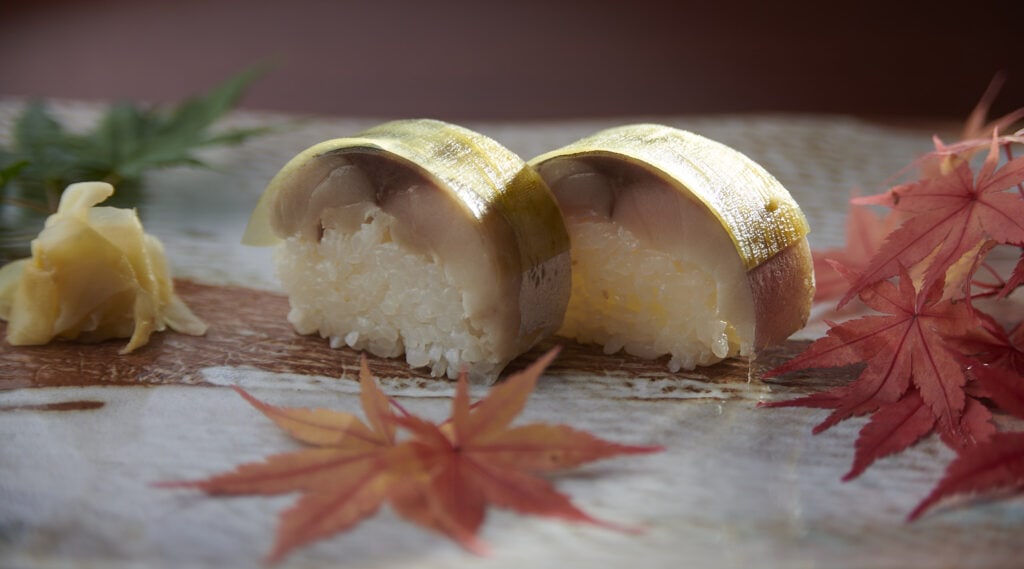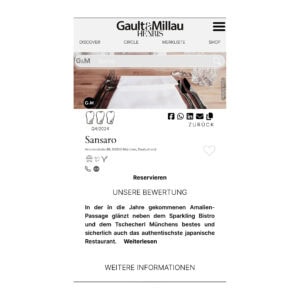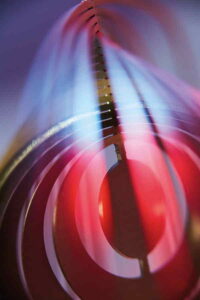Sushi has not only been reinvented again and again internationally, but has already developed quite differently in Japan over the past centuries. Many regions of Japan still know their very own interpretation of sushi. And these are partly not even known in the West!
Even in Japan, the different regional variants are not known everywhere. Sushi that is only available locally is called Kyodo sushi. It is particularly interesting that the local sushi variants of the large, cosmopolitan cities such as Tōkyō and Ōsaka change continuously. The local variants of the smaller cities, on the other hand, remain the same.
Bō-sushi from Kyōto
Bō-sushi (棒鮨 or 棒寿司) is a very old, traditional form of sushi known mostly from Kyōto.
It consists of a half cut fish fillet placed on vinegar leavened rice. The two ingredients are pressed together and formed into the shape of a stick. For this purpose, one uses a cloth or alternatively a maki-su.
Typically, very specific types of fish are used for Bō-sushi. This can be half or whole mackerel marinated in vinegar, a salmon or even a freshwater fish.
The fish, without cutting it into pieces, is placed on the rice, and then rolled into a long, thin shape. The textile traditionally used for this is called sarashi (さらし), but the maki-su (巻き簾) is also commonly used for this purpose.
Saba sushi is a kind of Bō sushi
A very typical example of Bō-sushi is the saba-sushi, mackerel sushi, coming from Kyōto.
During the Edo period (江戸時代, Japanese Edo-jidai, 1603 - 1868), salted and preserved fish was brought from the sea to urban centers. Some roads between Wakasa in Fukui Prefecture and Kyōto were considered famous transport routes for salted mackerel. That is why these roads are still called Saba-Kaido (mackerel road).
In 1781, a restaurant in Kyōto called Izuu began preparing Bō-sushi with mackerel. This dish quickly became a specialty that the people of Kyōto appreciated, especially on festive occasions.
Bō-sushi becomes really tasty after about half a day when the mackerel goes into a slight aging process with the vinegary rice.
Even today, you can find many stores in Kyōto that offer this local specialty.

Temari sushi - practical balls for maiko
Temari-zushi (手毬寿司) is a particularly bite-sized sushi. It is so called because it resembles the shape of a ball (毱) played with by hand (手).
Actually, already the typical sushi shapes like Nigiri, Makimono and others always in a bite-size. Temari, however, are again smaller and rounder.
The exact history of temari-zushi is not known. But it is said to have originated when maiko (the traditional Japanese entertainers in the Hanamachi district of Kyōto) cut sushi into even smaller pieces to avoid getting smeared with lipstick - and to eat simply and elegantly.
The sushi rice is formed into a round ball and sometimes topped with pickled vegetables, shiso leaves or other ingredients, and raw fish. Temari-zushi can be served in a variety of ways depending on the ingredients used, and seasonal ingredients can be used relatively freely, making it suitable for a variety of occasions due to its gorgeous colors.
Mushi sushi: Steamed sushi from the Ōsaka area.
Sushi is not always a cold or body-warm dish, nor do the ingredients necessarily have to be raw. This is particularly impressively demonstrated by mushi sushi (蒸し寿司, steamed sushi).
Mushi sushi is prepared by placing the cooked, different colored ingredients on the vinegary rice and then steaming^ the whole thing.
This is not to be thought of as nigiri sushi or maki sushi. This is chirashi sushi, which is actually a bowl of rice with chopped ingredients placed on it
The name of Mushi Sushi comes from this form of preparation, because the Japanese verb mushi means "to steam".
Origin of mushi sushi not quite clear
There are different theories as to where mushi sushi originally came from. One sees the beginnings of steamed sushi in the area around Ōsaka and Kyōto, another in Nagasaki.
There are some facts in favor of both theories.
In Nagasaki, a restaurant opened in 1866 that served chawanmushi (steamed egg custard) and began selling steamed sushi at the same time. In the Kanto region, this form of sushi is not usually found.
But Kyōto is also home to a very famous restaurant specializing in mushi sushi to this day. The light scent of vinegar spreading in the cool air during steaming is one of the typical winter smells around the restaurant in Kyōto.
Sasa sushi: sushi in bamboo leaf
Sasa sushi (笹寿司) is a typical representative of local sushi specialties. The sushi variety is at home in the northern Nagano region and consists of vinegar-soured rice, ingredients and seasonings on a
Bamboo leaf.
Common ingredients for sasa sushi include bracken and dried royal fern. Tsukudani, foods cooked in soy sauce, such as shiitake, walnuts and boiled egg, and red ginger are also typical ingredients.
Sasa sushi may have been around for quite a long time. According to legend, the dish was invented about 450 years ago when a group around the warlord Uesugi Kenshin (上杉謙信) passed through northern Nagano.
The army went to war, and the people of Dor gave the brave heroes rice and side dishes on bamboo leaves. Bamboo is useful because the leaves have antibacterial, antiseptic and deodorant ingredients. Bamboo leaves are something like the historical natural precursor of cling film.
Sasa-maki is also described for Edo. In fact, the sources are quite good, there are recipes from the 15th century that describe the preparation of sasa-maki
Kakinoha sushi: Sushi in persimmon leaf
Kakinoha sushi comes from Nara.
In the middle of the Edo period (1603 - 1868), mackerel preserved with salt was cheaply available in Nara, which was far from the sea. The mackerel was thinly sliced and placed on bite-sized pieces of vinegar-acidified rice.
These pieces wrapped the leaves of the cacao tree and packed the whole in wooden boxes. A stone on the packets pressed the fish and rice together. Packed in this way, the sushi was allowed to ferment under the influence of lactic acid bacteria.
The area around Gozo and the Yoshino River is known for the cultivation of persimmons. Therefore, it was natural here in this area to use the leaves of the cacao tree as packaging material.
Persimmon leaves have acid-resistant and antibacterial properties. They contain a lot of tannin (a tannin) and vitamin C. To this day, tea is made from the leaves.
Today, not only salted mackerel is used for kakinoha sushi in the Nara area, but also salmon and sea bream mixed with sweet rice vinegar.
Masu sushi: sushi with trout in Toyama prefecture
Actually, sushi is prepared with seafood and fish from the ocean - but it was not always so. In Toyama Prefecture, a variant prepared with cherry trout from the river Hinzu has survived to this day.
Masu sushi (鱒寿司) was probably first prepared in the middle of the Edo period, about 200 years ago. It is a type of haya sushi, so the ingredients are not prepared over a
fermented for a longer period of time.
Jinzu trout, also known as cherry salmon, stand out for their elegant sweetness and contain a lot of fat. Therefore, according to ancient sources, they were consumed as nare sushi as early as the Heian period (794 - 1185).
Masu sushi preparation
The preparation of masu sushi is somewhat special. On the bottom of a wooden bowl called a wappa (曲物, literally a bent thing), bamboo leaves are laid out in a radiating pattern. On top of this, salted or vinegar soured trout and vinegar soured rice are placed. The whole is pressed alternately into the bowl. A specially adapted lid is placed on the bowl and canted with a still green bamboo stick
In summer, masu sushi keeps for about two days, and in winter - a whole week. Trout and leavened rice ripen due to the special form of storage and get a very special flavor from the bamboo leaves.
Kabura sushi from Kanazawa city in Ishikawa prefecture
Kabura sushi (かぶら寿司) is a typical winter specialty in Kanazawa and especially popular as a meal at New Year. It is a type of nare sushi, or fermented sushi. Vinegar-soured rice, actually an essential ingredient for sushi, plays no role at all here.
Kabura sushi is basically yellowtail, a type of mackerel (Australian yellowtail). The fish is packed between salted white beets and marinated in Kōji (麹). For about two to three days, you keep this mixture in the refrigerator.
Mamakari sushi from Kurashiki in Okayama Prefecture
Sappa is a fish from the herring family.
In the Kurashiki region, this fish is also known as mamakari. The fish with the striking blue back is caught in Japan exclusively in spring and autumn. Sappa from the Seto Sea is particularly popular because of its sweet taste and high fat content. A good 90 percent of the catch is consumed in Okayama.
There is a nice story surrounding the term mamakari: it is said that when sappa is available, people eat so much that they run out of rice (まま mama). As a consequence, they have to borrow rice from their neighbors (仮 kari).
Mamakari sushi is made from sappa that has been pickled in vinegar. Available as nigiri sushi and Bō-sushi, you actually have to try Mamakari sushi whenever you have the opportunity in Kurashiki!
Bara sushi - also from Okayama
About 390 years ago, the feudal ruler of Bizen-Okayama issued an edict that people who ate only one soup and one other dish per meal would recover more quickly from the devastating flood in Bizen. The man, Mitsumasa Ikeda, was considered a wise monarch.
Although the daily meals were very simple, people wanted to eat numerous different dishes when they were celebrating or there was a special occasion. So that they could continue to feast and still abide by the decree of their wise monarch, they invented a mixed sushi of various kinds of fish and vegetables, all of which came from the Setouchi region. They declared this composition of numerous different dishes to be a separate dish (bara sushi) - thus the rules were satisfied.
Kakushi sushi: even more hidden calories!

Inari sushi: sushi in honor of the rice god
Always ideal as a take-out
Origin of inari sushi unclear
There are several theories about where Inari sushi comes from. The origin is simply not clear. But the name Inari-Sushi is mentioned in documents from the late Edo period (1853 - 1868).
Inari is the name of a shrine dedicated to the deity Ukanotama. Ukanotama is the god of the five grains. Ukanotama has a messenger who appears in the form of a fox. The fox figures are also often named as Inari.
The name inari sushi may come from the shape of the rice balls, which represent fertility. A fox's ears are triangular - and in many regions, inari sushi is triangular as well. And finally, it is said that foxes prefer to eat fried tofu.
The combination of vinegar-soured rice and the fine juice that oozes from the fried tofu also has a nostalgic, heartwarming feel for Japanese.






